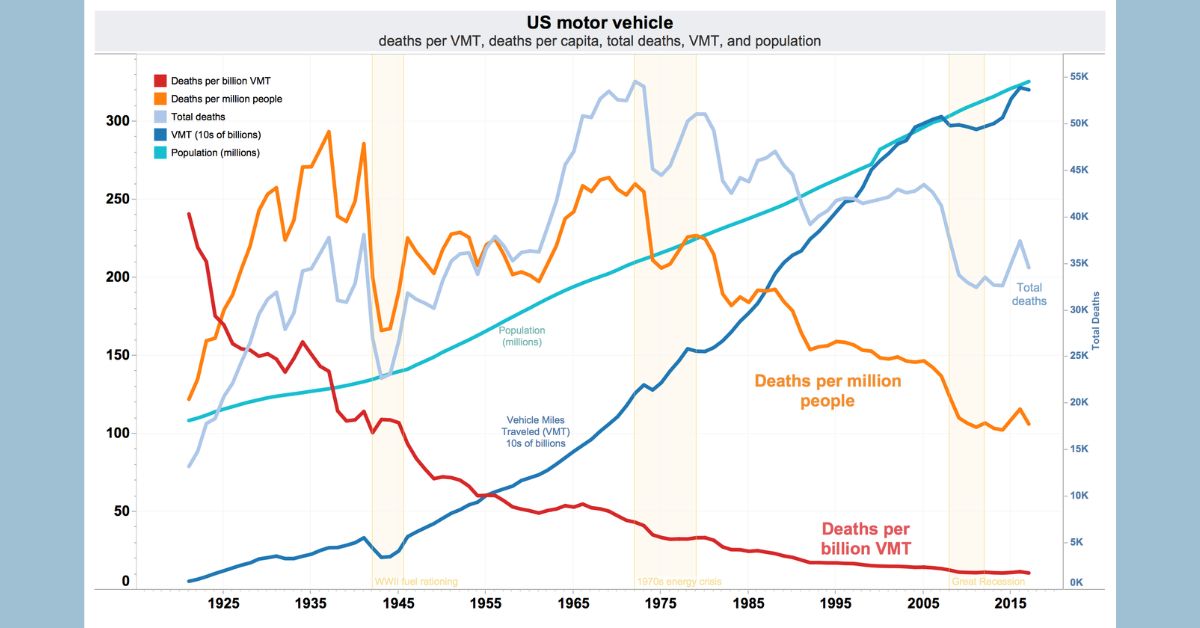The rate of motor vehicle fatalities in the United States is an important number that indicates the safety of the country’s roadways as well as the success of various safety measures and policies.
Over time, analyzing this data provides significant insights into patterns, variables impacting rates, and the impact of measures targeted at lowering deaths. This article delves into the historical motor vehicle fatality rates in the United States and investigates the underlying causes that contribute to these trends. In this article, we’ll learn more Motor Vehicle Fatality Rate in the U.S. By Year.
Trends Over the Years
The motor vehicle fatality rate in the United States has seen significant fluctuations and variations over its history. These oscillations are driven by a complex interplay of factors ranging from advances in car technology to changes in driving patterns.
Decline and Stabilization
Motor vehicle mortality rates in the United States fell significantly from the 1970s to the early 2000s. This decrease can be ascribed to the use of critical safety equipment including seatbelts, airbags, and better road infrastructure. These measures resulted in a significant reduction in fatalities and heralded a time of increased road safety awareness.
However, the tendency shifted in the mid-2000s. The fatality rate has stabilized, with rare modest rises in particular years. Several factors led to this shift, including an increase in total kilometers driven, changes in driving practices, and the growth of distracted driving as a result of mobile device proliferation.
A Tweet posted by the official account of Benedict Evans:-
Fun with numbers: US motor-vehicle deaths if the rate of deaths-per-vehicle-mile had not improved. pic.twitter.com/vqYjinAgta
— Benedict Evans (@benedictevans) April 22, 2023
Factors Influencing Fatality Rates
Several key factors contribute to the fluctuation in motor vehicle fatality rates:-
- Technological Advancements: The continuous evolution of vehicle safety technology has played a significant role in reducing fatality rates. Features like antilock braking systems (ABS), electronic stability control (ESC), and advanced driver assistance systems (ADAS) have contributed to safer driving experiences.
- Regulations and Legislation: Changes in traffic laws and regulations have impacted fatality rates. The introduction of seatbelt laws, stricter drunk driving penalties, and graduated driver’s licensing for teenagers has contributed to overall road safety.
- Economic Conditions: Economic downturns have historically been associated with lower fatality rates as people tend to drive less when facing financial constraints. Conversely, during periods of economic growth, more people are employed and may be commuting longer distances, potentially leading to an increase in accidents.
-
Driving Behaviors: Behavioral factors such as speeding, distracted driving, and impaired driving significantly contribute to motor vehicle fatalities. Public awareness campaigns and education initiatives aim to address these behaviors and promote safer driving practices.
Conclusion:- For more latest updates, stay connected with us always. Check out blhsnews.com for the most recent news. You should save our site to your bookmarks so you can return to read our most recent posts as soon as they become available.
Check out the posts below if you’re interested in reading more about the news:-
- St. Mary’s Resident Fatally Shot By Police In Friday Morning Accident In Celina
- Iconic Portland TV News Anchor Mike Donahue Dies At 77
Patricia Gault is a seasoned journalist with years of experience in the industry. She has a passion for uncovering the truth and bringing important stories to light. Patricia has a sharp eye for detail and a talent for making complex issues accessible to a broad audience. Throughout her career, she has demonstrated a commitment to accuracy and impartiality, earning a reputation as a reliable and trusted source of news.
Contents











